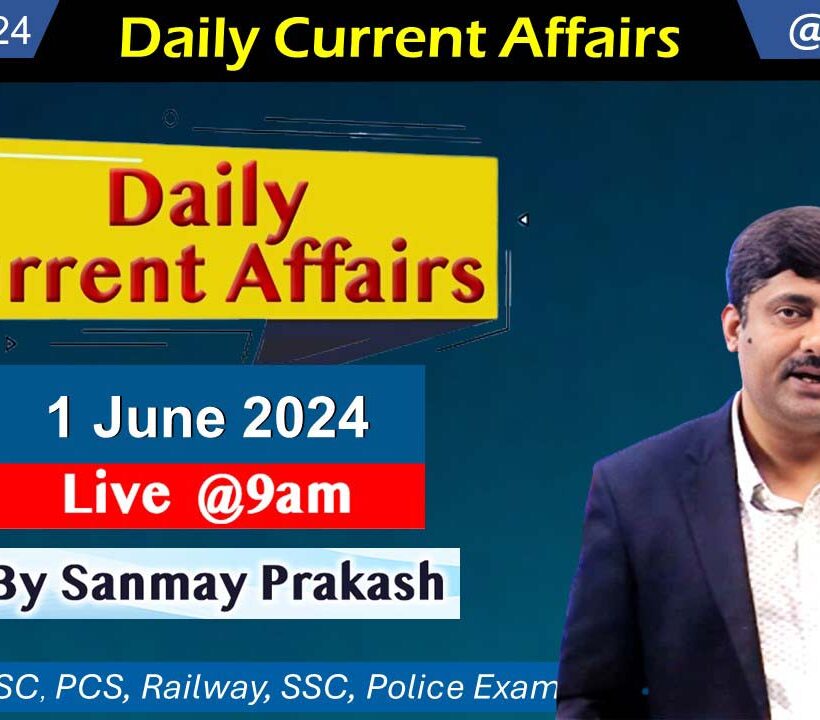This is the current affairs of 1 June 2024. Here are questions and answers of daily current affairs for better preparation of competitive exams for government jobs.
PDF Download: Click here
1. From which country did RBI recall 100 tonnes of gold from the Indian gold reserves kept abroad?
a. Britain
b. Japan
c. Russia
d. America
Answer: a. Britain
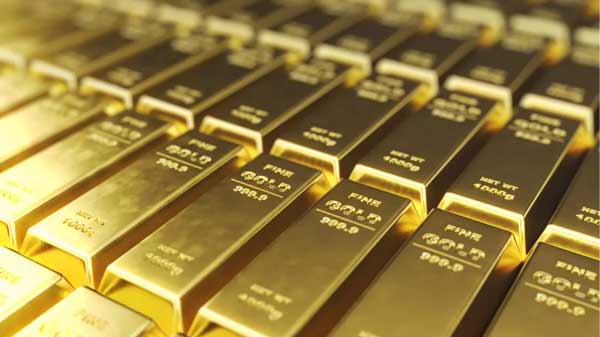
– The RBI has recalled its 100 tons (about 100,000 kg) of gold from the Bank of England in Britain.
– A special aircraft was used to transport the gold.
– The RBI has not disclosed when the gold was recalled, but it is believed that this happened confidentially between April and May 2024.
– This is the largest movement of gold in the country since 1991. At that time, due to the foreign exchange crisis, India had to pledge a large portion of its gold, resulting in the gold being taken out of the RBI’s vaults. However, the current situation is the – opposite. This movement of gold is to keep the stock in possession.
India’s Gold Reserve
– According to the RBI, by the end of the fiscal year 2023-24 (March 2024), the RBI had a total of 822.1 tons of gold, of which 413.8 tons were deposited abroad.
– Of this, 100 tons of gold have been recalled.
India Bought a Lot of Gold!
– About 15 years ago, the RBI bought 200 tons of gold from the International Monetary Fund (IMF).
– In 2009, during the tenure of the UPA government when Manmohan Singh was the Prime Minister, India bought 200 tons of gold at a price of $6.7 billion to diversify its assets.
– In the past few years, there has been a continuous increase in the gold stock purchased by the Reserve Bank.
Gold Maintains Economic Stability
– If a country’s currency weakens internationally, gold reserves help maintain its economic stability.
– In 1991, when India’s economy was sinking and it did not have dollars to import goods, it raised money by pledging gold.
– A large reserve of gold signifies a strong economy.
Why Gold Reserves Are Kept Abroad
– Central banks of many countries prefer to keep gold in various locations to minimize risk. These risks can be of various types – particularly natural, economic, and political.
– Natural disasters can also damage gold reserves. Storing gold in different locations reduces this risk.
– In India, the RBI reviews where and how much gold should be stored after purchasing it.
– Since the stock abroad was increasing, it was decided to bring some gold back to India.
– This move also reflects the strength and confidence of our economy.
Britain is a Gold Repository for Many Central Banks
– Britain’s ‘Bank of England’ has been a gold reserve store for many central banks.
– Since before India’s independence, some amount of gold has been stored in London because before independence, Britain kept India’s gold in the Bank of England.
– Even after independence, India decided to keep some gold in the Bank of England in London as well as in other places.
Why Did India Need to Bring Back the Gold Reserve?
– In fact, West Asia, Europe, and East Asia are experiencing instability.
– Considering the volatile global developments, all major central banks are bringing their gold reserves back to their countries.
– Britain has just emerged from an economic recession and elections are due there next month, creating many uncertainties.
– Due to these various reasons, the RBI had to bring gold back to India.
Instability in West Asia, Europe, and East Asia
– West Asia: There is a war ongoing between Israel and Hamas. Countries like Iran, Syria, Lebanon, and Yemen are indirectly involved.
– Europe: The war between Russia and Ukraine is at a turning point. The President of France is determined to send military trainers to Ukraine. Finland, Denmark, and Canada have allowed Ukraine to use their weapons to attack within Russia. With the permission of the US and European countries for Ukraine to use their weapons to attack within Russia, Russia now has an excuse to attack Ukrainian cities and government buildings. Until now, Russian attacks have primarily targeted military, energy, and infrastructure sites, but this situation is likely to change.
– East Asia: China conducted military exercises encircling Taiwan in May 2024. The efforts made by the US to increase tensions in the region in recent years could also escalate into a war. China and Russia appear to be aligned.
European Countries Froze Russia’s Gold
– There are also significant disadvantages to keeping gold reserves abroad.
– When Russia attacked Ukraine in February 2022, European countries froze Russia’s gold.
– This was done due to American sanctions.
As a result, Russia can only use its foreign gold reserves if the sanctions are lifted.
– In such a situation, central banks of many countries around the world are recalling their gold.
How the Gold Was Brought and Stored
– Months of planning were undertaken to bring 100 tons of gold to India. The planning and execution involved the Ministry of Finance, RBI, and other government wings along with local authorities.
– The RBI received customs duty exemption to bring the gold to India. However, no exemption was given on the integrated GST imposed on imports.
– This is because this tax is shared with the states.
– A special aircraft was used to transport the gold.
– This step will also help the RBI save some storage costs, which it used to pay to the Bank of England.
– The gold is stored in the old building of the Reserve Bank office on Mint Road in Mumbai.
– Additionally, gold storage with full security is done in vaults in Nagpur.
————–
2. Which country is leading in terms of gold reserves?
a. India
b. America
c. Italy
d. Germany
Answer: b. America
– According to Forbes India’s report, the United States holds the first position in terms of gold reserves.
– The United States has a reserve of 8,133.46 tons of gold.
Top 10 Countries
1- United States (8,133.46 tons)
2- Germany (3,352.65 tons)
3- Italy (2,451.84 tons)
4- France (2,436.88 tons)
5- Russia (2,332.74 tons)
6- China (2,235.39 tons)
7- Switzerland (1,040.00 tons of gold)
8- Japan (845.97 tons)
9- India (803.58 tons)
10- Netherlands (612.45 tons)

————–
3. What was the GDP growth rate in the fourth quarter of the financial year 2023-24?
a. 7.8%
b. 7.9%
c. 8.1%
d. 8.2%
Answer: a. 7.8%
Fourth quarter of the financial year: January to March 2024
– The manufacturing sector saw the highest growth rate in this quarter, with a growth rate of 8.9%.
– This was followed by the construction sector at 8.7%, public administration at 7.8%, electricity at 7.7%, and finance and real estate at 7.6% growth rate.
GVA at 6.3% in the Fourth Quarter
– Gross Value Added (GVA) stood at 6.3% in the fourth quarter of the financial year 2024. This is an increase from the annual GVA rate of 7.2%.
– A year ago, in FY23, the GVA growth was 7.0%.
Note – China recorded an economic growth rate of 5.3% in the first three months of 2024.
————–
4. What was the GDP growth rate in the financial year 2023-24?
a. 7.8%
b. 7.9%
c. 8.1%
d. 8.2%
Answer: d. 8.2%
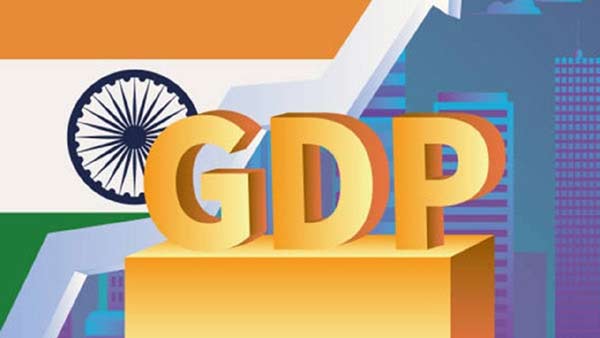
Who released the GDP growth rate figures?
– The National Statistical Office (NSO) released the provisional GDP figures on May 31, 2024.
– According to these figures, the GDP growth rate from April 2023 to March 2024 was 8.2%.
– In the previous financial year, i.e., 2022-23, the GDP growth was 7%.
What was the GDP in rupees?
– The actual GDP or nominal GDP for 2023-24 was ₹173.82 lakh crore.
– Whereas the first revised estimate (FRE) for GDP for the year 2022-23 was ₹160.71 lakh crore.
What was the growth rate in each quarter?
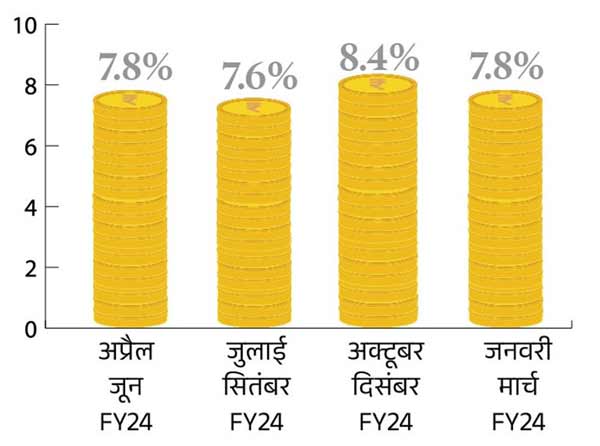
India’s economy has reached $3.5 trillion
– The GDP growth rate has propelled the Indian economy to $3.5 trillion.
– Plans are in place to achieve the target of $5 trillion in the coming years.
Fiscal deficit has increased
– For the financial year 2023-24, the fiscal deficit has reached 5.63% of the Gross Domestic Product (GDP).
– In real terms, the fiscal deficit, the gap between expenditure and revenue, was ₹16.53 lakh crore.
– However, this is lower than the estimate. The government had projected a fiscal deficit of 5.8%.
Government’s annual expenditure: ₹44,42,542 crore
– Revenue expenditure: ₹34,94,036 crore (including ₹10,63,871 crore in interest payments and ₹4,13,542 crore in subsidies)
– Capital expenditure: ₹9,48,506 crore
What is GDP?
– Gross Domestic Product (GDP) is one of the most common indicators used to track the health of an economy.
– GDP refers to the total value of all goods and services produced in a country during a year or a quarter.
– GDP is the largest measure of a country’s economic development.
– A higher GDP implies that the economy is growing, generating more employment opportunities.
– A lower GDP indicates economic setbacks, with rising unemployment issues.
– It is calculated as follows: GDP = C + I + G + (X-M)
Where:
C = Consumer Expenses
I = Industries’ Investment
G = Government Expenditure
X = Exports
M = Imports
There are two types of GDP:
– Real GDP and Nominal GDP.
– Real GDP calculates the value of goods and services based on the base year’s value or stable prices. Currently, the base year for calculating GDP is 2011-12.
– Meanwhile, Nominal GDP is calculated at current prices.
What is Gross Value Added (GVA)?
– In simple terms, GVA reveals the total output and income in an economy. It indicates how much value of goods and services was produced during a certain period after deducting input costs and raw material prices. It also indicates the level of production in specific sectors, industries, or areas.
– From the perspective of national accounting, after subtracting subsidies and taxes from GDP at the macro level, what remains is GVA. If you look at it from the production perspective, you will find it as an item balancing national accounts.
GVA in Different Sectors:
Primary Sector (Primary Sector)
– Agriculture, Livestock, Forestry, Fishing: 1.4%
– Mining: 7.1%
Secondary Sector (Secondary Sector)
– Manufacturing: 9.9%
– Electricity, Gas, Water Supply: 7.5%
– Construction: 9.9%
Tertiary Sector (Tertiary Sector)
– Trade, Hotels, Transport, Communication: 6.4%
– Financial, Real Estate: 8.4%
– Public Administration, Defense, and Other Services: 7.8%
————–
5. Who has been appointed by the Central Government as the new Chairman of the Staff Selection Commission (SSC)?
a. Ashim Khurana
b. Rakesh Ranjan
c. S Kishore
d. Pradeep Surana
Answer: b. Rakesh Ranjan
– The Central Government announced their appointment as the Chairman of SSC on May 27, 2024.
– Prior to this, they served as the Special Secretary of the Department of Agriculture and Farmer Welfare.
– They are an IAS officer of the 1992 batch from the Manipur cadre.
– Now, as the Chairman of SSC, they will work on the position and salary of the Secretary of the Government of India with the new orders.
————–
6. When is Goa State Day celebrated?
a. 30 May
b. 31 May
c. 29 May
d. 28 May
Answer: a. 30 May
– Situated on the western coast of India, Goa attracts tourists with its magnificent beaches and rich history.
– For over 450 years, Goa was a Portuguese colony.
– In 1961, India liberated it and made it a Union Territory along with Daman and Diu.
– On May 30, 1987, it was granted full statehood, becoming the 25th state of the Indian Union.
– In commemoration of this event, May 30 is celebrated as Goa Statehood Day.
Note: Goa Liberation Day is celebrated on December 19 to mark the success of Operation Vijay carried out by the Indian Armed Forces in 1961.
– Capital: Panaji
– Language: Konkani
– Population: 1.4 million
– Chief Minister: Pramod Sawant
– Governor: P.S. Sreedharan Pillai
– Neighboring States: Maharashtra, Karnataka

————-
7. Which Indian Grandmaster defeated world number one Magnus Carlsen for the first time in a classical game at the Norway Chess Tournament?
a. D Gukesh
b. Anish Giri
c. Vidit Gujrathi
d. R Praggnanandhaa
Answer: d. R Praggnanandhaa
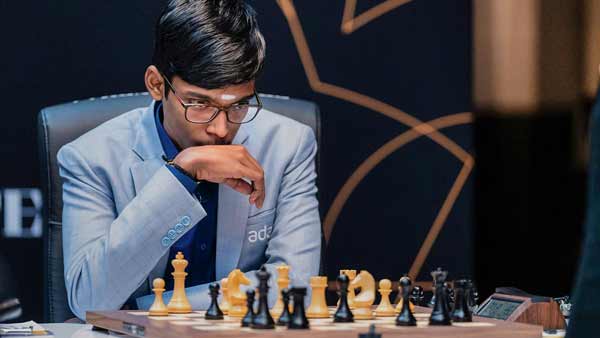
– On May 29, 2024, R. Praggnanandhaa defeated Magnus Carlsen in the classical game at the Norway Chess Tournament.
– This was his first victory against Carlsen.
Magnus Carlsen is the world’s number one chess player and hails from Norway.
– Carlsen and Praggnanandhaa drew all three of their matches in this format.
– Praggnanandhaa secured the top position with 5.5 points after three rounds.
What is Classical Chess?
– Classical chess, also known as slow chess, allows players ample time to make their moves.
– In this game, players can take up to 1 hour for their moves.
R. Praggnanandhaa:
– He is an Indian grandmaster, aged 18.
– His full name is Rameshbabu Praggnanandhaa.
– He was born on August 10, 2005, in Chennai.
– He is the younger brother of Indian chess player Vaishali Rameshbabu.
—————
8. DRDO test fired RudraM-II missile from Su-30 MKI fighter aircraft. Which of these missiles is this?
a. Surface to air anti-radiation missile
b. Air-to-air indigenous missile
c. Air-to-surface anti-radiation missile
d. None of these
Answer: c. Air-to-surface anti-radiation missile
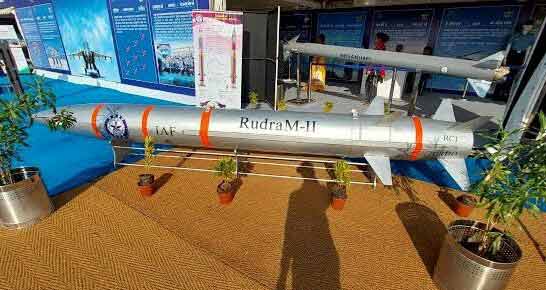
DRDO: Defence Research and Development Organisation
– An anti-radiation missile is a type of missile designed to destroy enemy radar and communication equipment.
– The RudraM-II missile is designed to detect, track, and neutralize enemy radar, communication equipment, and other radio frequency sources, which are typically part of their air defense systems.
– DRDO successfully tested the Rudra M-II missile from an Su-30 MKI jet off the coast of Odisha on May 29, 2024.
Note:
– Previously, the final test of RudraM-I was conducted in 2020.
– The RudraM-III missile is currently under development.
Features of the Missile
– The RudraM-II is an indigenously developed solid-fuel air-to-surface missile system.
– It is capable of air-to-surface strikes to destroy various types of enemy weaponry.
– The missile has a range of 350 km.
– It can capture signals from enemy radio frequency and radar from a distance of over 100 km.
About DRDO
– Chairman: Dr. Sameer V. Kamat
– Establishment: 1958
– Headquarters: DRDO Bhavan, New Delhi
DRDO plays a major role in making India self-reliant in the defense sector.
—————
9. Who became the new Director General of the World Organisation for Animal Health (WOAH)?
a. Dr. Emmanuelle Soubeyran
b. Dr. Harsh Vardhan
c. Dr. Vishal Agarwal
d. Dr. Robert D’Souza
Answer: a. Dr. Emmanuelle Soubeyran
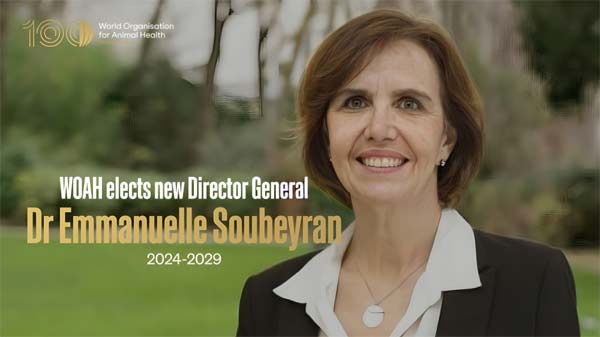
– They have been elected as the Director General of the World Organisation for Animal Health (WOAH) for the term 2024-2029.
– They are from France.
– They were elected to this position at the World Assembly of Delegates held in Paris on May 28.
WOAH
– Establishment – 25 January 1924
– Headquarters – Paris
– Member countries – 183 (India is also a member)
—————
10. Who has been appointed as the new Managing Director and CEO of National Asset Reconstruction Company (NARCL)?
a. Aftab Warsi
b. Narendra Malhotra
c. P. Santosh
d. TK Mukherjee
Answer: c. P. Santosh
– He was earlier working as the Acting CEO.
– In May 2024, he became the MD and CEO of National Asset Reconstruction Company (NARCL) for a term of three years.
PDF Download: Click here

